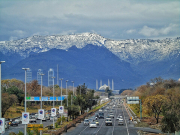
Ice sheets covering Greenland and Antarctica are melting three times faster today than they were in the 1990s, according to a "definitive" study of satellite data.
The amount of ice lost is enough to raise world sea levels by almost one millimetre a year. Since 1992, it has added 11.1 millimetres to global sea levels - contributing around a fifth of the total rise.
About two thirds of the ice loss was from Greenland and the remainder from Antarctica, said scientists.
Until now, there has been confusion over what is happening to the ice sheets in a warming world. Estimates have differed greatly, with some studies even suggesting gains rather than losses.
The new survey, published in the journal Science, is said to be the most accurate assessment to date - ending 20 years of uncertainty. It confirms that, with the exception of East Antarctica, both land masses are losing ice. But big differences in the pace of change were seen at each pole.
While the rate of ice loss from Greenland had increased almost five-fold since the mid-1990s, it had remained fairly constant in Antarctica.
Study leader Professor Andrew Shepherd, from the University of Leeds, said: "The success of this venture is due to the co-operation of the international scientific community, and due to the provision of precise satellite sensors by our space agencies. Without these efforts, we would not be in a position to tell people with confidence how the Earth's ice sheets have changed, and to end the uncertainty that has existed for many years."
The study showed that between 1992 and 2011, more than 4,000 gigatonnes of ice was lost from the Antarctic and Greenland ice sheets. A gigatonne is one billion tonnes. Despite its much smaller size, the Greenland ice sheet shed the most - 2,940 gigatonnes.
Speaking at a news conference in London, Prof Shepherd said that although no coastal cities had been flooded in the past 20 years, there were real concerns about what might happen in the next century.
He added: "The data do show clearly there are parts of the ice sheets that are responding in exactly the way we would expect them to respond - in a negative way - as a result of changes in their local climate." The research highlighted parts of Antarctica where the ice was "clearly not behaving in a normal way", said Prof Shepherd. "It's unstable and it's accelerating and it's sea level contribution is rising year-on-year," he said. "Greenland even more so, we see that very clearly. That allows us to say to the people who build models for future climate projections that these are the areas you should concentrate on."
The Press Association, photo by Dave Marcus








































